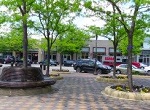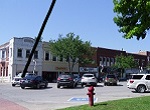Shade Structures Can Soften a Severe Environment or Create a New Destination
Published: November 17, 2025
In many cases, you can improve resident enjoyment and utilization of your parks, greenways, business districts, plazas, and other public spaces if you provide shade structures. We would be the first to say that the best shade is Mother Nature's trees, but they take time to grow and are not appropriate to every situation. You might need some alternatives.
Perhaps the most common shade structure now is what is sometimes called the shade sail, a canvas structure of either predictable or creative design. These have become popular simply because they work. If you can make them eye-catching in color or design, so much the better. This one in Denver, together with a little artificial turf, planters, and some picnic tables, creates an outdoor room.

The shade sails can be simple or elaborate, covering a small area or a more expansive space, such as the one illustrated below.

Think of other places where people might like shade too. For example, check out the system of shade structures over a fitness area on the Lafitte Greenway in New Orleans.

One question surrounding shade sails is their maintenance and longevity. While the colors may be vibrant for a while, inevitably some fading will occur. Possibly they also will sustain damage from flying debris or vandalism. Consider carefully whether their placement will cause conflicts later and how they will look and function after a few years.
Don't be afraid to install a simple stationary umbrella, such as the one below, where you do not necessarily anticipate or want to encourage people lingering. As construction continued, the landscaping contrasted more sharply with this unexpected orange umbrella.

Pergolas, Arbors, and the Like as Shade Structures
Another common approach to the shade structure is the pergola, which isn't quite as quick as erecting a shade sail but still is considerably speedier than growing new shade trees, even if there is room for them.
Here is one that had yet to be planted when I snapped this photo in Las Vegas.

Here's a welcome structure in Indianapolis, akin to an awning in size and shape, with nice plantings growing already.

In addition to providing needed shade, the wooden pergola below also heightens the importance of an entrance or even invites a bit of mystery about what is behind the door at the far end of the perspective.

Although I find it somewhat puzzling, I also notice pergola-like structures being intentionally left bare, both to suggest an awning visually but also supposedly to supply a little shade. Considering that I routinely try to fit myself into the shadow of a traffic light pole near my house on sunny days, I suppose that isn't necessarily a surprise. I just have to think that a regular awning would do a better job of providing shade though.
Arbors and other attractively designed shapes also are possibilities; when planted this arbor provided quite a bit of shade a couple of years later.

Roofs and Pavilions for Shade
Lastly, of course you could use conventional park pavilions and various kinds of simple roof structures and lean-tos as shade. This first one below is presumably an off-the-shelf gazebo, such as ones often found in parks and on business, educational, or church campuses. This particular example already has been outfitted with park benches, so there is every reason to recognize this as a shade structure even though I believe it is most often used as a small event space or focal point. Seriously consider this type of structure if would like something more robust than the sail-like fabric, but you will need to consider size of the structure so that pairs or groups traveling together do not feel too constrained when sharing space with strangers.

Lastly, below are a couple of park picnic shelters that might be reconsidered to emphasize their function as shade structures. In a way, I'm surprised more such simple conversions have not been occurring; all that is needed to change a picnic pavilion to a shade structure is to replace the picnic tables with seating benches to the extent you think the benches will be more needed. (But renting picnic pavilions will be more profitable, so it really isn't a mystery, is it?)
The first one is a typical picnic pavilion found in many parks, and the second a delightful historic pavilion from Tower Grove Park in St. Louis, just for your viewing pleasure. Either of these could be positioned as a shade structure in an area where these are needed.
It didn't seem right to close this page without commenting that the best shade structures are still trees, but when the beautiful leafy kind of shade structure is impractical, these artificial ways of supplying shade will be welcomed in this warming world.


Related Reading
- Community Development >
- Community Beautification > Shade Structures
Join GOOD COMMUNITY PLUS, which provides you monthly with short features or tips about timely topics for neighborhoods, towns and cities, community organizations, and rural or small town environments. Unsubscribe any time. Give it a try.





